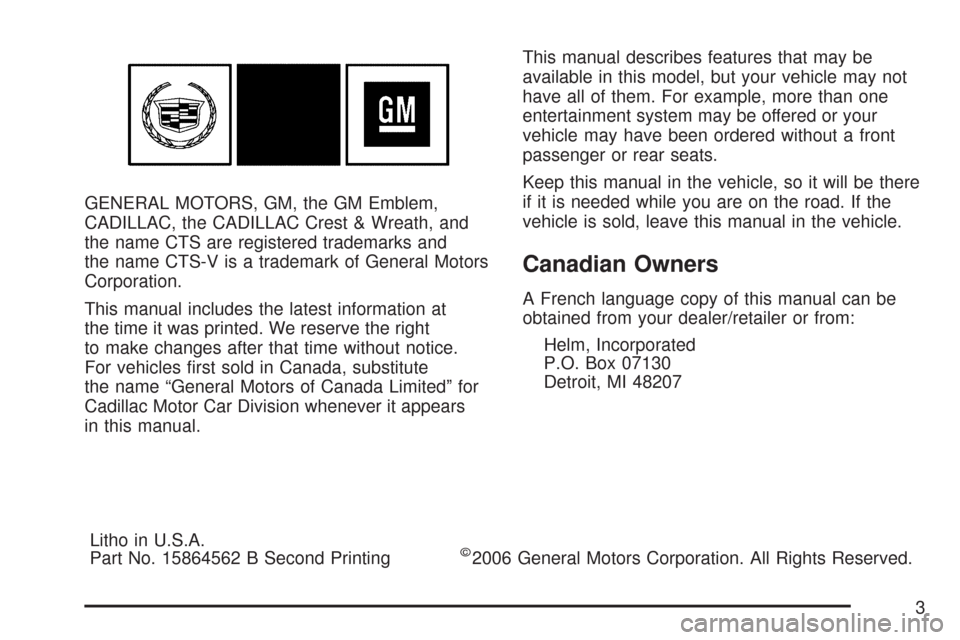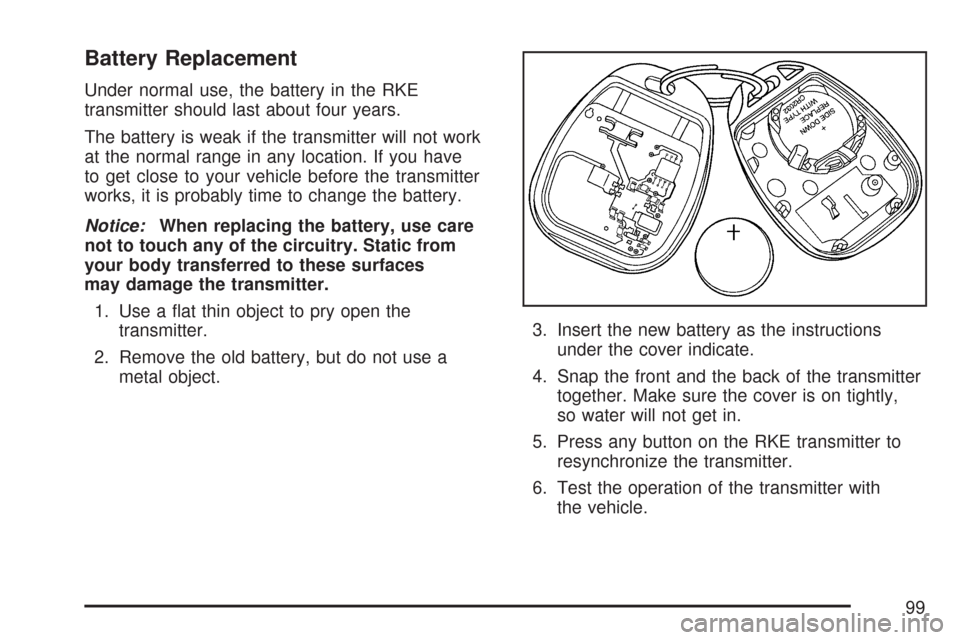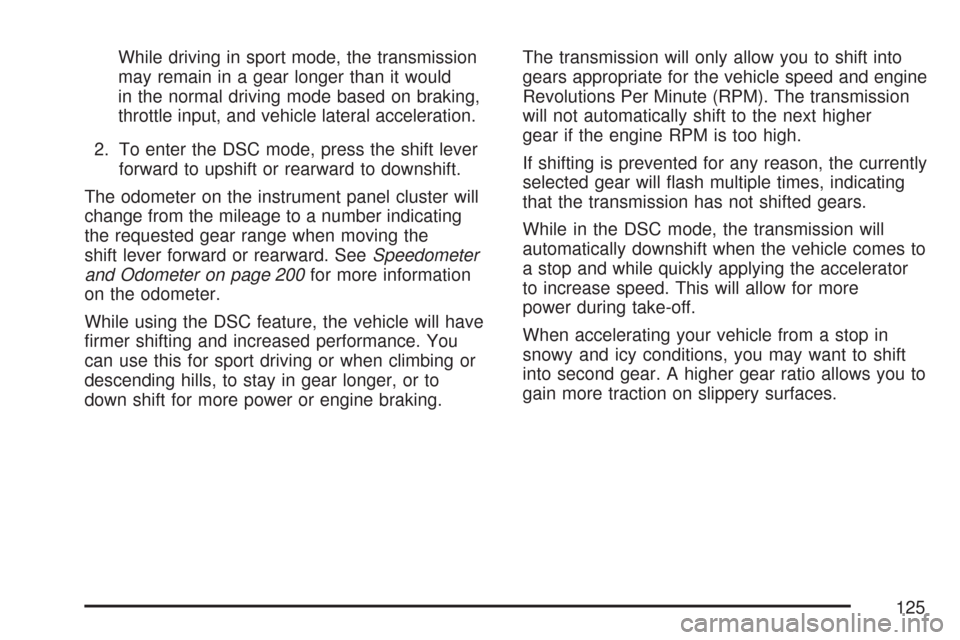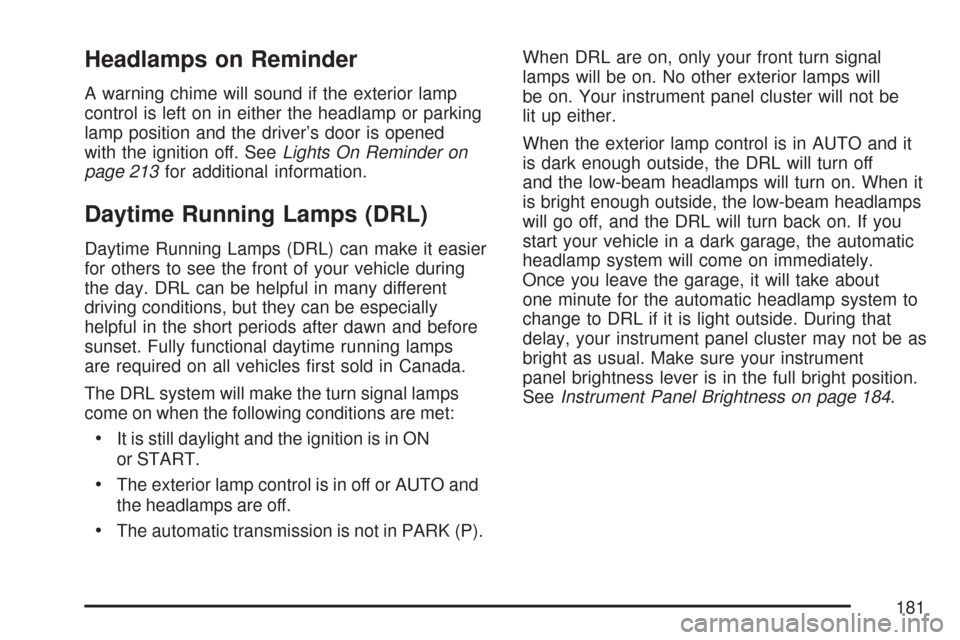change time CADILLAC CTS 2007 1.G Owners Manual
[x] Cancel search | Manufacturer: CADILLAC, Model Year: 2007, Model line: CTS, Model: CADILLAC CTS 2007 1.GPages: 518, PDF Size: 2.77 MB
Page 3 of 518

GENERAL MOTORS, GM, the GM Emblem,
CADILLAC, the CADILLAC Crest & Wreath, and
the name CTS are registered trademarks and
the name CTS-V is a trademark of General Motors
Corporation.
This manual includes the latest information at
the time it was printed. We reserve the right
to make changes after that time without notice.
For vehicles �rst sold in Canada, substitute
the name “General Motors of Canada Limited” for
Cadillac Motor Car Division whenever it appears
in this manual.This manual describes features that may be
available in this model, but your vehicle may not
have all of them. For example, more than one
entertainment system may be offered or your
vehicle may have been ordered without a front
passenger or rear seats.
Keep this manual in the vehicle, so it will be there
if it is needed while you are on the road. If the
vehicle is sold, leave this manual in the vehicle.
Canadian Owners
A French language copy of this manual can be
obtained from your dealer/retailer or from:
Helm, Incorporated
P.O. Box 07130
Detroit, MI 48207
Litho in U.S.A.
Part No. 15864562 B Second Printing
©2006 General Motors Corporation. All Rights Reserved.
3
Page 45 of 518

Infants and Young Children
Everyone in a vehicle needs protection! This
includes infants and all other children. Neither the
distance traveled nor the age and size of the
traveler changes the need, for everyone, to use
safety restraints. In fact, the law in every state
in the United States and in every Canadian
province says children up to some age must be
restrained while in a vehicle.{CAUTION:
Children can be seriously injured or
strangled if a shoulder belt is wrapped
around their neck and the safety belt
continues to tighten. Never leave children
unattended in a vehicle and never allow
children to play with the safety belts.
Every time infants and young children ride in
vehicles, they should have the protection provided
by appropriate restraints. Young children should
not use the vehicle’s adult safety belts alone,
unless there is no other choice. Instead, they need
to use a child restraint.
45
Page 99 of 518

Battery Replacement
Under normal use, the battery in the RKE
transmitter should last about four years.
The battery is weak if the transmitter will not work
at the normal range in any location. If you have
to get close to your vehicle before the transmitter
works, it is probably time to change the battery.
Notice:When replacing the battery, use care
not to touch any of the circuitry. Static from
your body transferred to these surfaces
may damage the transmitter.
1. Use a �at thin object to pry open the
transmitter.
2. Remove the old battery, but do not use a
metal object.3. Insert the new battery as the instructions
under the cover indicate.
4. Snap the front and the back of the transmitter
together. Make sure the cover is on tightly,
so water will not get in.
5. Press any button on the RKE transmitter to
resynchronize the transmitter.
6. Test the operation of the transmitter with
the vehicle.
99
Page 125 of 518

While driving in sport mode, the transmission
may remain in a gear longer than it would
in the normal driving mode based on braking,
throttle input, and vehicle lateral acceleration.
2. To enter the DSC mode, press the shift lever
forward to upshift or rearward to downshift.
The odometer on the instrument panel cluster will
change from the mileage to a number indicating
the requested gear range when moving the
shift lever forward or rearward. SeeSpeedometer
and Odometer on page 200for more information
on the odometer.
While using the DSC feature, the vehicle will have
�rmer shifting and increased performance. You
can use this for sport driving or when climbing or
descending hills, to stay in gear longer, or to
down shift for more power or engine braking.The transmission will only allow you to shift into
gears appropriate for the vehicle speed and engine
Revolutions Per Minute (RPM). The transmission
will not automatically shift to the next higher
gear if the engine RPM is too high.
If shifting is prevented for any reason, the currently
selected gear will �ash multiple times, indicating
that the transmission has not shifted gears.
While in the DSC mode, the transmission will
automatically downshift when the vehicle comes to
a stop and while quickly applying the accelerator
to increase speed. This will allow for more
power during take-off.
When accelerating your vehicle from a stop in
snowy and icy conditions, you may want to shift
into second gear. A higher gear ratio allows you to
gain more traction on slippery surfaces.
125
Page 163 of 518

Instrument Panel Overview........................ 166
Hazard Warning Flashers.......................... 168
Other Warning Devices............................. 168
Horn.......................................................... 168
Tilt Wheel.................................................. 169
Recon�gurable Steering Wheel
Controls (SWC) (CTS)........................... 169
Turn Signal/Multifunction Lever.................. 171
Turn and Lane-Change Signals................. 171
Headlamp High/Low-Beam Changer.......... 172
Flash-to-Pass............................................ 172
Windshield Wipers..................................... 173
Windshield Washer.................................... 174
Headlamp Washer..................................... 175
Cruise Control........................................... 176
Headlamps................................................ 180
Wiper Activated Headlamps....................... 180
Headlamps on Reminder........................... 181
Daytime Running Lamps (DRL)................. 181
Fog Lamps................................................ 183
Exterior Lighting Battery Saver.................. 183
Instrument Panel Brightness...................... 184
Entry Lighting............................................ 184Parade Dimming........................................ 185
Reading Lamps......................................... 185
Electric Power Management...................... 185
Battery Run-Down Protection..................... 186
Accessory Power Outlet(s)........................ 186
Ashtray(s) and Cigarette Lighter................ 188
Climate Controls......................................... 189
Dual Climate Control System..................... 189
Outlet Adjustment...................................... 194
Passenger Compartment Air Filter............. 195
Steering Wheel Climate Controls (CTS)..... 196
Warning Lights, Gages, and Indicators..... 197
Instrument Panel Cluster........................... 198
Speedometer and Odometer...................... 200
Trip Odometers......................................... 200
Tachometer............................................... 200
Engine Speed Limiter................................ 201
Safety Belt Reminder Light........................ 201
Airbag Readiness Light............................. 201
Passenger Airbag Status Indicator............. 202
Charging System Light.............................. 204
Brake System Warning Light..................... 205
Section 3 Instrument Panel
163
Page 172 of 518

Turn Signal On Chime
If the turn signal is left on for about 1 mile (1.6 km),
a warning chime will sound and the TURN
SIGNAL ON message will appear on the Driver
Information Center (DIC) display. See “Turn Signal
On” underDIC Warnings and Messages on
page 232for more information.
Headlamp High/Low-Beam Changer
Push forward on the turn signal/multifunction
lever to change the headlamps from low to high
beam. Pull the lever back and then release it
to change from high to low beam.
If you turn the vehicle off with the high beams on,
the high beams will be on the next time you
start your vehicle.
This light on the
instrument panel cluster
will be on, indicating
high-beam usage.
Flash-to-Pass
This feature allows you to use the high-beam
headlamps to signal the driver in front of you that
you want to pass.
Pull and hold the turn signal/multifunction lever
toward you to use this feature. When you do this,
the following will occur:
If the headlamps are off, in low-beam or in
Daytime Running Lamps (DRL) mode, the
high-beam headlamps will turn on. They will
stay on as long as you hold the lever
there. Release the lever to turn them off.
If the headlamps are in high-beam mode, they
will switch to low beam. To return to
high-beam, push the lever away from you.
172
Page 181 of 518

Headlamps on Reminder
A warning chime will sound if the exterior lamp
control is left on in either the headlamp or parking
lamp position and the driver’s door is opened
with the ignition off. SeeLights On Reminder on
page 213for additional information.
Daytime Running Lamps (DRL)
Daytime Running Lamps (DRL) can make it easier
for others to see the front of your vehicle during
the day. DRL can be helpful in many different
driving conditions, but they can be especially
helpful in the short periods after dawn and before
sunset. Fully functional daytime running lamps
are required on all vehicles �rst sold in Canada.
The DRL system will make the turn signal lamps
come on when the following conditions are met:
It is still daylight and the ignition is in ON
or START.
The exterior lamp control is in off or AUTO and
the headlamps are off.
The automatic transmission is not in PARK (P).When DRL are on, only your front turn signal
lamps will be on. No other exterior lamps will
be on. Your instrument panel cluster will not be
lit up either.
When the exterior lamp control is in AUTO and it
is dark enough outside, the DRL will turn off
and the low-beam headlamps will turn on. When it
is bright enough outside, the low-beam headlamps
will go off, and the DRL will turn back on. If you
start your vehicle in a dark garage, the automatic
headlamp system will come on immediately.
Once you leave the garage, it will take about
one minute for the automatic headlamp system to
change to DRL if it is light outside. During that
delay, your instrument panel cluster may not be as
bright as usual. Make sure your instrument
panel brightness lever is in the full bright position.
SeeInstrument Panel Brightness on page 184.
181
Page 189 of 518

Climate Controls
Dual Climate Control System
With this system you can control the heating,
cooling, and ventilation for the vehicle.
Automatic Operation
AUTO (Automatic):When this button is pressed
and the temperature is set, the system will
automatically control the inside temperature, the air
delivery mode, the air conditioning compressor, and
the fan speed. AUTO will appear on the display.
1. Press the AUTO button.
2. Adjust the temperature to a comfortable
setting between 70°F (21°C) and 80°F (27°C).Choosing the coldest or warmest temperature
setting will not cause the system to heat or cool
any faster. If you set the system at the warmest
temperature setting, the system will remain in
manual mode at that temperature and it will not
go into automatic mode.
In cold weather, the system will start at
reduced fan speeds to avoid blowing cold air
into your vehicle until warmer air is available.
The system will start out blowing air at
the �oor but may change modes automatically
as the vehicle warms up to maintain the
chosen temperature setting. The length of time
needed for warm up will depend on the
outside temperature and the length of time
that has elapsed since your vehicle was
last driven.
3. Wait for the system to regulate. This may take
from 10 to 30 minutes. Then adjust the
temperature, if necessary.
You can switch from English to metric units through
the Driver Information Center (DIC). If you have the
Base audio system, seeDIC Main Menu on
page 228. If you have the Navigation system, see
“Setup Menu” in the Index of the Navigation System
Owner Manual.
Uplevel Version Shown, Base Similar
189
Page 190 of 518

The air-conditioning system removes moisture
from the air, so you may sometimes notice a small
amount of water dripping underneath your
vehicle while idling or after turning off the engine.
This is normal.
Do not cover the solar sensor located in the
center of the instrument panel, near the
windshield. For more information on the solar
sensor, see “Sensors” later in this section.
Manual Operation
yNz(Mode):Pressing the mode switch and
changing the mode cancels automatic operation
and places the system in manual mode. Press
AUTO to return to automatic operation.
The outboard air outlets will always receive air�ow
regardless of the mode selected. SeeOutlet
Adjustment on page 194to change this air�ow
from the outboard outlets.To change the current mode, select one of the
following:
Y(Vent):This mode directs air to the instrument
panel outlets.
\(Bi-Level):This mode directs approximately
half of the air to the instrument panel outlets,
and then directs most of the remaining air to the
�oor outlets. In automatic operation, cooler air
is directed to the upper outlets and warmer air to
the �oor outlets.
[(Floor):This mode directs most of the air to
the �oor outlets with some air directed to the
outboard outlets (for the side windows), and a little
air directed to the windshield.
The mode switch can also be used to select the
defog mode. Information on defogging and
defrosting can be found later in this section.
yAz(Fan):Press this switch to increase or
decrease the fan speed. Pressing this switch
cancels automatic operation and places the system
in manual mode. Press AUTO to return to
automatic operation.
190
Page 225 of 518

Vehicle Information Menu Item
Descriptions
The following paragraphs contain a more detailed
description of each menu item:
OUTSIDE TEMP:If you select this item, the
current outside temperature is displayed at the top
of the screen. It will be in either degrees
Fahrenheit (°F) or degrees Celsius (°C) depending
upon whether the system is set for English or
metric units. If you wish to change the units, see
DIC Main Menu on page 228.
MI TRIP A and B (KM TRIP A and B):For
information on the trip odometers, seeTrip
Odometers on page 200.
MILES RANGE (KM RANGE):If you select this
item, the approximate number of remaining
miles or kilometers you can drive without refueling
is displayed. This estimate is based on the
current driving conditions and will change if the
driving conditions change. For example, if you are
driving in traffic making frequent stops, the
display may read one number, but if you enter the
freeway, the number may change even thoughyou still have the same amount of gas in the gas
tank. This is because different driving conditions
produce different fuel economies. Generally,
freeway driving produces better fuel economy than
city driving.
If your vehicle is low on fuel, the Fuel Level Low
message will be displayed. See “Fuel Level
Low” underDIC Warnings and Messages on
page 232for more information.
MPG AVG (L/100 KM AVG):If you select this
item, the approximate average miles per
gallon (mpg) or liters per 100 kilometers (L/100 km)
is displayed. This number is calculated based
on the number of mpg (L/100 km) recorded since
the last time this menu item was reset.
To reset the MPG AVG (L/100 KM AVG), press
the CLR button located to the right of the screen.
The display will return to zero.
MPG INST (L/100 KM INST):If you select this
item, the current fuel economy is displayed. This
number re�ects only the fuel economy that the
vehicle has right now and will change frequently as
driving conditions change. Unlike average fuel
economy, this menu item cannot be reset.
225